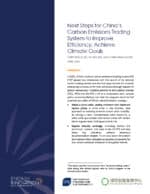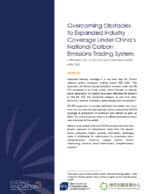In 2021, China’s national carbon emissions trading system (ETS) became fully operational, regulating electric power plants with plans to expand to other industries by 2025. Once expanded to industry (e.g. aluminum, cement, and steel), the China ETS will cover more greenhouse gas emissions than any other single climate policy in the world, leaving little doubt about the importance of the China ETS for a stable climate. This three-part report series provides design guidance to strengthen the China ETS, maximize its emissions-reduction potential and economic benefits, as well as guidance for cooperation with the European Union.
Report: Next steps for China’s ETS
This report offers design recommendations to help China’s emissions trading system reach its full potential as a pillar of the country’s decarbonization strategy while spurring domestic innovation and enhancing global competitiveness, including hastening expansion to other industry sources, transitioning to a mass-based cap, using a consignment approach to overcome legal and political obstacles to auctioning, and leveraging non-greenhouse gas data collected by the National Environmental and Monitoring Center to cross-check carbon emissions data reported by enterprises.
Report: Overcoming Obstacles to Expanded Coverage
This report recommends a three-step approach for overcoming information and political economy challenges obstacles to expanding the China ETS. First, address competitiveness concerns by introducing a price collar. Second, embrace benchmark simplification. Third, spotlight the growing clean tech opportunities that will be enhanced for industries added to the China ETS.
Report: China and the European Union
This report examines the EU’s proposed carbon border adjustment mechanism (CBAM) and provides policy recommendations for both the EU and China to support mutually beneficial cooperation on climate. To expand the CBAM’s upsides and limit negative effects, China should expeditiously move forward with expanding coverage and strengthening its ETS, while the EU should counter unfairness complaints by dedicating CBAM fees to compliance assistance for developing countries as well as account for decarbonization policies other than those setting a directly observable carbon price.



